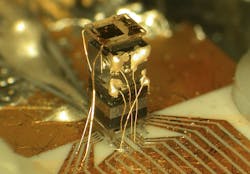Northrop Grumman to design clocks with microsecond precision for positioning, navigation, and timing (PNT)
ARLINGTON, Va. – U.S. military researchers needed ultra-small low-power clocks to help military forces maintain precise positioning, navigation, and timing (PNT) in case that GPS navigation satellites are damaged, destroyed, or jammed. They found their solution from Northrop Grumman Corp.
Officials of the U.S. Defense Advanced Research Projects Agency (DARPA) in Arlington, Va., announced a $6.2 million contract to Northrop Grumman in Falls Church, Va., last week for the H6 program.
The H6 project of the DARPA Microsystems Technology Office seeks to develop ultra-small, low power clocks that can maintain microsecond precision for at least one week in temperatures from -40 to 85 degrees Celsius.
Ubiquitous compact timing today remains critical not only for navigation, but also for communications, electronic warfare (EW), and intelligence, surveillance, and reconnaissance (ISR).A tactical-grade clock that maintains weeklong microsecond timing would remove PNT timing from dependence on navigational satellites for the majority of U.S. military missions, and enable signal assurance, pervasive communications security, and high-bandwidth communications.
Today, no such fieldable tactical-grade clock exists; while there are clocks which can achieve the necessary performance, their size, weight, and power consumption (SWaP) limitations preclude their use in a tactical setting.
DARPA researchers asking Northrop Grumman engineers to design SWaP-constrained clocks that rely on compound mechanical clock technologies; sub-terahertz molecular clock technologies; or something completely different.
H6 refers to an 18th Century British ocean-navigation project that in five increments developed precise chronometers the helped British ocean navigators determine their vessels' positions in longitude to prevent catastrophes like the 1707 Scilly Naval Disaster that wrecked four British warships and killed between 1,400 and 2,000 sailors due to navigational errors.
British inventor John Harrison developed five generations of clocks, which he called H1 through H5; the last one was the first marine chronometer with the accuracy necessary to determine longitude accurately. Navigators can determine latitude with sextants using the sun and stars; determining longitude, however, requires precise clocks.
H6 is the spiritual successor to Harrison’s maritime chronometers. While the longitude problem was the preeminent PNT challenge of the last millennium, GPS denial is the greatest problem today, DARPA researchers point out.
H6 will be a five-year, three-phase program. The first phase will focus on clock dependence on temperature and SWaP reduction, while the second phase will focus on clock aging throughout the tactical temperature environment. The third phase will demonstrate an integrated tactical-grade clock and build five clocks.
For more information contact Northrop Grumman online at www.northropgrumman.com, or DARPA at www.darpa.mil.
About the Author
John Keller
Editor-in-Chief
John Keller is the Editor-in-Chief, Military & Aerospace Electronics Magazine--provides extensive coverage and analysis of enabling electronics and optoelectronic technologies in military, space and commercial aviation applications. John has been a member of the Military & Aerospace Electronics staff since 1989 and chief editor since 1995.
